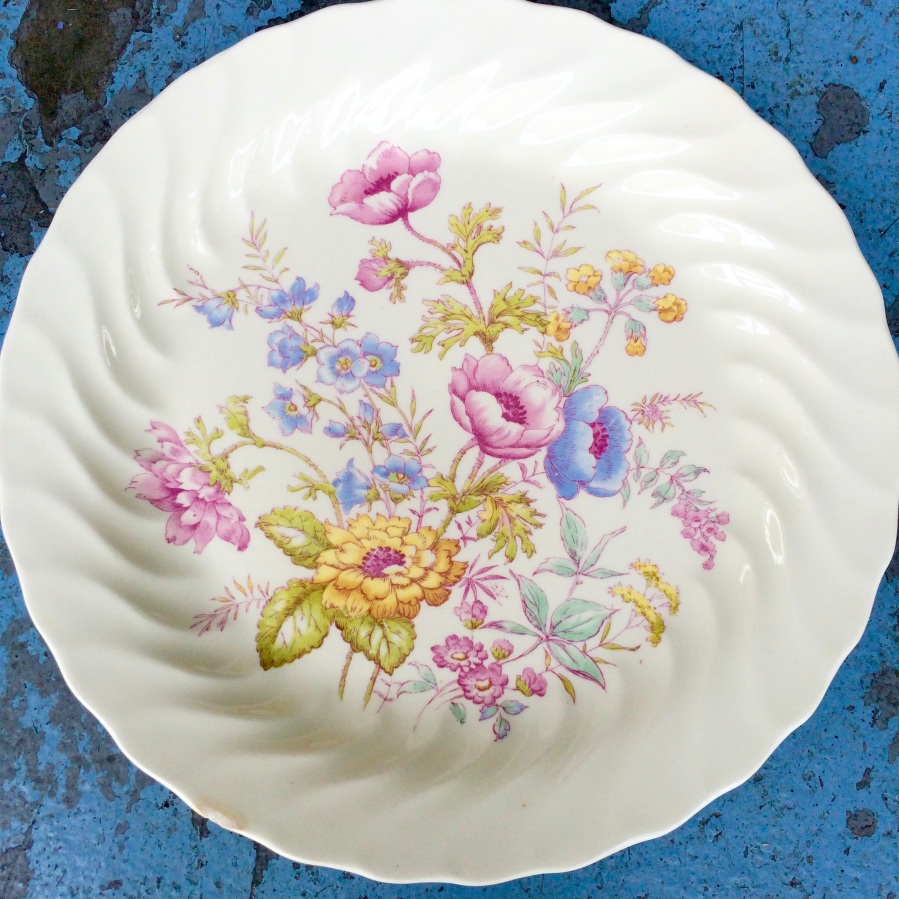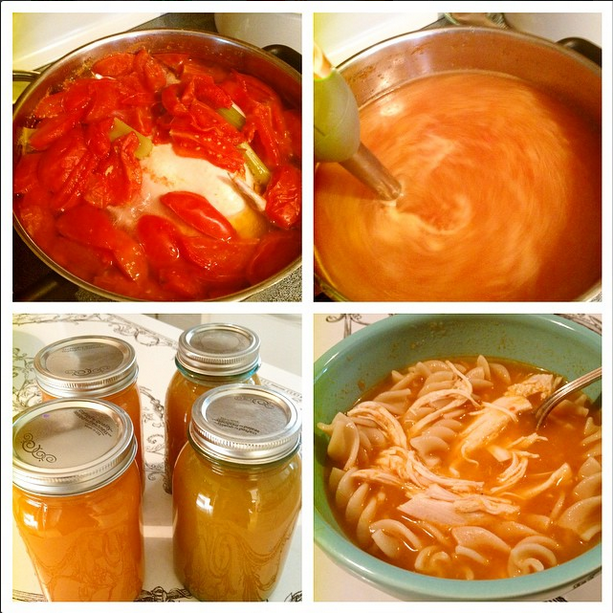My Nonny’s China (with a recipe for Minestra, an Italian peasant soup)
If there’s something my Italian heritage has taught me, it’s that food brings people together. Not just to eat it. Making pasta is a family assembly line, taking an entire day of talking and drinking wine while hands busily fold and seal tortellini. You make lots and you invite the neighbors. Food is tradition and hospitality, love and gift, shared enterprise and social do.
So when my mom called a few weeks ago and said, “We’re cleaning out the storage unit. Are you interested in Nonny’s china?” the question was one of inheriting family culture more than practicality.
I was still in the process of Konmari-ing (massively purging) my house and the idea of bringing anything new into it felt perhaps as it would if someone were asking me to become a surrogate mother weeks after giving birth to my own child. Nothing else is coming in here right now, thank you! But I had no recollection of what the china actually looked like (my mother had never used it) and I am a sucker for vintage decor.
“I’ll look at the print to see if I like it,” I told her.
A few days later my parents came over and I went with my dad out to his truck to look at the china. I felt a bit like a sucker being led to survey the wares in the trunk of a conman’s car–surely this would not be the heirloom score I secretly hoped for.
My dad opened a box, pulled out an object ensconced in newspaper and began to unwrap it. At first glimpse I saw cream with a scalloped edge. Not quite my style. A little too 1960’s for me. But then he handed me the plate.

It had a floral print at the center: bell flowers, poppies and dahlias in pink, blue and yellow. The style was circa 1930s and was the exact colors of my existing decor. If I had seen this plate in a thrift shop, I would thank providence and buy it on the spot.
I ended up with four boxes of the china, a full set of twelve seven-piece settings, along with five or six serving pieces. Only one small plate was missing. As I unwrapped and washed the dishes, I wondered at who my great-grandmother was and what these dishes told me about her. How did she lose but one dish? Surely clumsy me who’s broken half my wedding registry in the last ten years could not be this woman’s descendant.
My Nonny (a pet version of Nonna, Italian for grandma), who was my dad’s grandma, died before I was born. But she and my Nonno were the cultural forebears of my family through the best and truest means: food. My dad grew up at his Nonny and Nonno’s table, at his mother’s table, and my Californian mom faithfully adopted the same recipes and made them a part of our family table. Chicken cacciatore, lasagna, minestra, cappelletti, spaghetti sauce (bolognese), anise biscotti, and on and on.
I remember rolling fresh pasta and making cappelletti (pronounced by my dad and grandma as ka-plit), for hours upon hours on our massive library-sized dining table. Our family’s cappelletti are small tortellinis filled with veal, cheese, lemon zest and nutmeg, to be eaten as a soup in a rich broth. As an adult when I went to visit East Coast family members I hadn’t seen since I was toddling, we immediately commenced a day of making “green lasagna”–essentially fresh spinach pasta cut into long thick ribbons, about the size of tagliatelle. It’s set out to dry for several hours or overnight, usually over a broom handle or on clean sheets on the bed–the culinary techniques of pragmatists and housewives. It’s cooked and served with bolognese sauce, which like most American families, we just call spaghetti sauce.
My Nonny and Nonno were from the Emilia Romagna region in north-central Italy–arguably the greatest culinary region of Italy from whence Parmigiano-Reggiano, balsamic vinegar, prosciutto de parma, and totellini all hail. With the advent of the internet, I now know that their dishes were all regional gems, but also unique family versions passed down from generation to generation.
Of all the recipes, the mainstay was minestra, (pronounced in my family as min-as-tra) which in Italian simply means “soup.” Americans are more familiar with minestrone, which basically means “big soup,” or “the mother of all soups.” Our minestra is a simple peasant soup of six ingredients: Chicken, tomatoes, celery, salt, water, and pasta. It’s basically Italian chicken noodle soup. I love that my family called it just soup, as if to say “What other soup would it be?”
As a child, my mother would start the soup before we left for church, leaving it to simmer until we came home. We would fight to be the first in the door to get the “first sniff.” It was a thing. My mom made this soup a lot for guests and for Sunday suppers, and she served it with the hot chicken meat on the side, fresh “French” bread, butter, and parmesan. I loved to make little sandwiches of the bread, butter, and chicken and to load my minestra with parmesan.
My Nonno was the pasta-master in the family and the few times my dad has made fresh pasta to go with minestra the way his Nonno made it, the noodles were tiny diamonds–I think it was meant to be something like orzo. My mom always just made it with egg noodles crunched into smaller pieces while still dry in the bag.
As an adult, this soup was one of the first things I made when I had my own apartment and now it’s on the regular rotation with our family meals. I make it when any of us are sick because the homemade stock is full of healing nutrients. I make it in the New Year when I’ve overdone the holiday eating and I need something warm and delicious and healthy to eat for awhile. It’s clean, filling food and I make it with rice noodles to suit my gluten-free preference.
Kids, even the pickiest eaters, inevitably love this soup. Corin, my three-year-old asks for it constantly and once sat on the kitchen island for thirty minutes saying “Chicken noodle soup!” over and over. Another time, it was far too late to make it in time for dinner, but he begged and begged and I broke down and made it, resulting in a 9:00 pre-bedtime bowl for him.
More than anything, this is communal food. It’s perfect for feeding a crowd, and the glorious thing about it is that it costs so little and is dead simple to make. It has often been my savior when I want to open my home to people, but feel desperately limited by budget and energy.
This is magic soup, I tell you.
The next time I saw my dad after getting Nonny’s china, he told me how he remembers eating “minastra” and “kaplit” out of those bowls as a little boy. I told him how shocked I was to find a complete 12-setting set. He told me the one missing dish had been commandeered by his sister Martha as a keepsake. “Did Nonny get them after her children were grown?” I asked, in awe at how a mother of four daughters could perform such a feat.
“Yes,” he said, “and she only used them for special occasions.”
I’m impressed by my Nonny’s scrupulousness, but I’ve decided if there’s something worth using, then it shouldn’t be saved for once-in-a-while. Nonny’s china is now our daily dishes. I have to confess I already broke a salad plate. But I’d rather break every dish sharing minestra with people who sit at our table then keep them all in a hutch somewhere gathering dust.

A recipe for Minestra
12-16 roma tomatoes, quartered
8-12 stalk celery, trimmed and cut into thirds
1 whole rinsed chicken
3-4 Tbs kosher salt
1 lb. pasta of your choice
To serve:
Parmigiano-Reggiano or Parmesan cheese, shredded
1. Put tomatoes, celery, chicken, and salt into a large stockpot and fill to 1 inch from the top with cold water.
2. Bring to a boil and simmer for one hour. Be careful not to overcook the chicken and allow the bones to fall into the stock.
3. Remove chicken and set aside.
4. Using an immersion blender, blend the vegetables into the stock until fully puréed. Alternatively, strain out vegetables and place in a blender. When fully puréed, add back to the stock.
5. Bottle or freeze 1/2-2/3 your stock for another time, unless feeding a crowd.
6. Bring remaining stock to a boil and add pasta. Turn heat down to med. low.
7. Meantime, clean your chicken, shredding the meat, and put into a serving bowl. I like to separate the dark from the white so people can choose their preference.
8. When noodles are not quite fully cooked, remove from heat and dish up (noodles will continue to cook). Kids might want an ice cube in their bowl to help cool it down.
9. Serve with shredded chicken meat and cheese on the side.
J.M. Roddy is a domestic creative, food-enthusiast, and children’s author.



Yum! I love the family history here too Joey! Surprised I’ve never had your soup…wink wink!
LikeLiked by 1 person
This article was delicious from start to finish. I love that you are using the china every day. I’m sooooo jealous of the print and style. Total score!
LikeLiked by 2 people
Loved your article!!! Ah, yes, Minestra – it’s the best.
Wait . . . you already broke a plate? I had that china for thirty years and didn’t break a plate . . . what’s up with that, girl?!
Dad
😀
LikeLike
I know it’s awful. I swear I’m at least trying to be very careful with it. But you know, you never broke a plate because you never took them out of the box to use them. 😉
LikeLike
Lovely, lovely, lovely. The memories that will be made by your readers when they start making this delicious meal…joy will be filling the table.
LikeLiked by 1 person